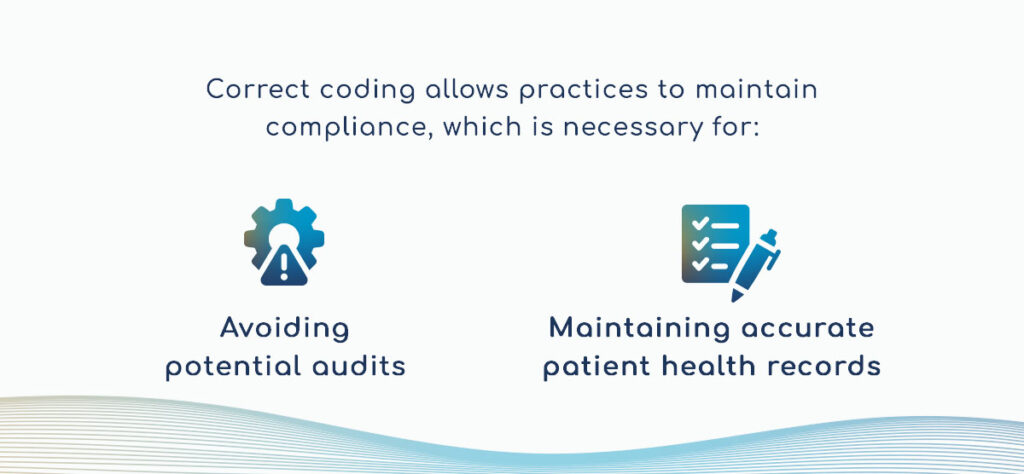Medical billing and coding involve translating services and diagnoses provided to patients into standardized codes and using those codes to submit claims to insurers. Accurate coding results in accurate billing, which improves revenue cycle management (RCM). Learn more about these processes and why precision and compliance are essential.
Why Is Coding Important?
The importance of medical coding can be categorized by revenue and compliance benefits.
Impact on Healthcare Revenue
Accurate coding helps healthcare practices:
- Ensure proper reimbursement for services provided: Medical billers and coders facilitate communication between providers and insurance companies. Accurate coding allows insurers to understand the diagnoses and services provided and reimburse the provider.
- Reduce claims denials: Claims denials can delay payments and take time to resolve. Precise coding can mitigate these issues.
- Build trust with patients: Accurate codes lead to accurate bills — and accurate bills improve the patient experience. Transparent, precise processes can build trust with patients and increase their likelihood of returning for services.
Coding Benefits for Compliance
Correct coding allows practices to maintain compliance, which is necessary for:

- Avoiding potential audits: While some audits are purely random, others are targeted investigations or happen because a practice raises a red flag on payor systems. Correct coding processes reduce the audit risk.
- Maintaining accurate patient health records: Thorough paperwork helps avoid medical errors and ensures patients receive the care they need. Coders and billers ensure bills reflect services provided and maintain consistency with patient health records. Proper records also ensure compliance with privacy laws like the Health Insurance Portability and Accountability Act (HIPAA) and can assist in case of an audit.
Common Code Sets
There are a few standard code classification systems.
ICD-10
The United States version of the International Classification of Diseases (ICD-10) codes was developed by the Centers for Medicare & Medicaid Services (CMS) and the National Center for Health Statistics (NCHS). It has two subsets:
- ICD-10-PCS: The International Classification of Diseases, Tenth Revision, Procedure Coding System.
- ICD-10-CM: The International Classification of Diseases, Tenth Revision, Clinical Modification.
ICD-10-PCS is used in hospital settings, while ICD-10-CM is used for medical claim reporting. ICD-10-CM codes were developed by the Centers for Disease Control and Prevention (CDC). They depict conditions and diseases, related health problems, signs and symptoms, and more.
ICD-10-CM codes have between three and seven characters. With each additional character, the code describes more specific diagnostic criteria.
CPT®
While ICD-10-CM codes describe diagnoses, Current Procedural Technology (CPT)® codes describe the services rendered. These codes are maintained by the American Medical Association (AMA) and indicate how to report procedures and services.
There are three types of CPT® codes:
- Category I: The most common codes that correspond to a service or procedure.
- Category II: Optional supplemental codes for measuring performance.
- Category III: Temporary codes for emerging procedures, services, and technology.
Category I codes are numerical, ranging from 00100 to 99499, while Category II and III codes are alphanumeric.
HCPCS
The Healthcare Common Procedure Coding System (HCPCS) consists of two code sets:
- HCPCS Level I: Part of the CPT® code set.
- HCPSC Level II: Identifies products, services, and supplies not included in the Level I codes.
The Level II code set identifies products and services like:
- Certain drugs and biologicals.
- Durable medical equipment, prosthetics, orthotics, and supplies (DMEPOS).
- Ambulance services.
All Level II codes have five characters — a letter and four numbers. The HCPCS Level II set also includes miscellaneous codes, known as not otherwise specified (NOS) or not otherwise classified (NOC) codes.
The Coding in Healthcare Process
The coding process translates medical information into a language insurance companies understand. Here’s a look at the process:
- Analyze medical records: The thoroughness and accuracy of medical records directly impact the accuracy of the coding process.
- Assign codes: After assessing patient medical records, coders assign the appropriate ICD-10, CPT®, and HCPCS codes.
Step-By-Step Guide to Billing
Following the coding process, the billing process can begin:
- Register the patient: Registering new patients involves capturing their health histories and insurance information. Billers must also update returning patients’ files.
- Verify insurance: This step determines what treatments are covered by the patient’s insurance plan.
- Capture codes: Billers capture the ICD-10 codes, CPT®, and sometimes HCPCS codes to cover diagnoses and services rendered.
- Create the claim: Reimbursement claims use information from documents called superbills. These documents are itemized lists of services patients receive from a healthcare provider.
- Submit to insurance company: After creating the claim, the medical biller files it with the insurance provider for reimbursement. Thorough and accurate claims are more likely to gain first-pass acceptance.
- Monitor payor adjudication: Insurers will accept, deny, or reject the claim. Healthcare practices should monitor the payor’s decision to address issues quickly.
- Bill the patient: Once the claim is approved and the payor has paid their share, it’s time to bill the patient and collect their payment.
Key Challenges in Medical Billing and Coding
Accurate medical billing and coding benefits practices by improving RCM and helping maintain compliance. However, the healthcare sector is ever-changing, which can present challenges, including:
- Complex regulations and coding updates: Medical codes are updated regularly to keep pace with the evolving healthcare environment. ICD-10 codes typically update annually on October 1, while CPT® code updates take effect each year on January 1. HCPCS Level II codes are updated at varying frequencies. While these updates are necessary to reflect advancements and new treatments, they can be difficult to monitor.
- Inadvertent upcoding: Poor documentation or code misinterpretation can lead to accidental upcoding — when a provider bills for a more complex or expensive procedure than the one provided, increasing reimbursement.
- Dealing with claims denials and rejections: Inaccurate coding or insufficient documentation that does not support the claims submitted can lead to denials or rejections, which can slow the reimbursement process.
- Maintaining patient data security and HIPAA compliance: Medical coders and billers handle protected health information (PHI), which is protected under HIPAA. They must keep PHI safe and secure to comply with regulations.
How DoctorsManagement, LLC, Can Help
DoctorsManagement, LLC, is committed to helping healthcare practices increase revenue, enhance productivity, and maintain compliance. We understand the importance of accurate coding and billing and why it can pose challenges for practices. Whether you want to conduct internal medical coding audits to assess your risk or improve your team’s efficiency, DoctorsManagement has a solution to help.
A comprehensive coding and documentation audit involves:
- Analyzing documentation according to payor reimbursement policies.
- Scrutinizing coding and documentation according to evaluation and management (E&M) billing regulations.
Our audit reviews reveal risk areas, allowing providers to increase efficiency, reduce administrative burden, improve RCM, and reduce the risk of payor prepayment audits.
We also offer medical coding and documentation training services. Our coding and auditing specialists receive support from the National Association of Medical Auditing Specialists (NAMAS), and our senior team members hold Certified Professional Coder (CPC)® and Certified Professional Medical Auditor (CPMA)® credentials. You can trust them to lead exceptional training sessions.
Contact Us for Audit Reviews or Medical Coding Services
DoctorsManagement simplifies the business of medicine. For more information on our audit reviews or medical coding and documentation training services, please contact us for a free consultation.
























